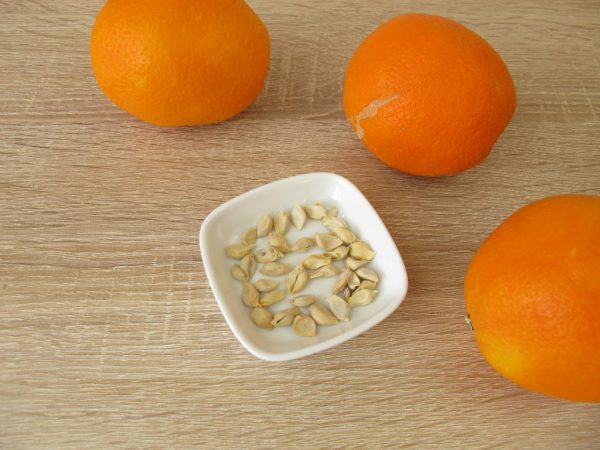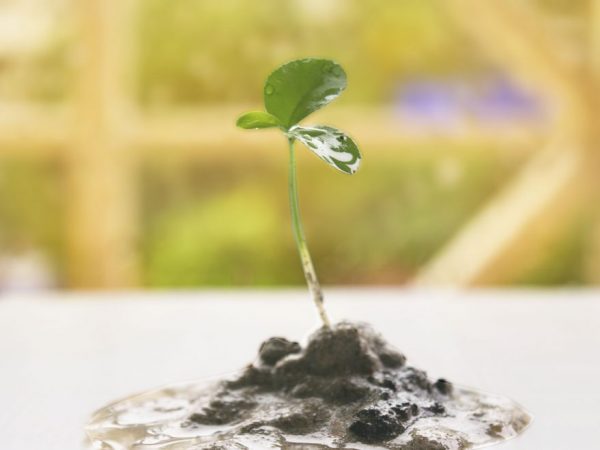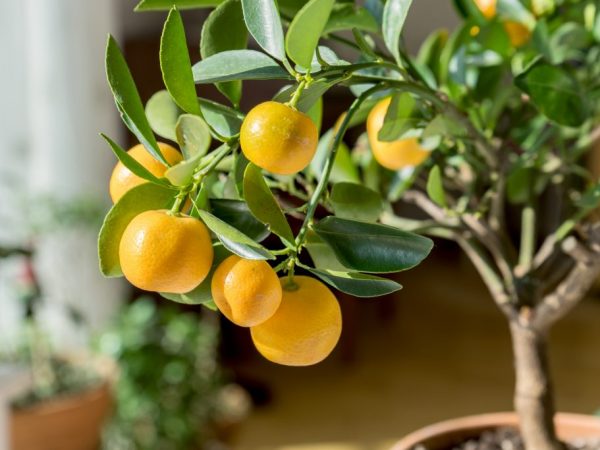Features of growing an orange from a seed at home
Citrus indoor plants can become a fragrant and exotic decoration of any room. Growing an orange from a seed at home is a simple and cost-effective process, so even a novice gardener can master it.

Features of growing an orange from a seed at home
Growing rules
Growing an orange tree at home from a seed is not difficult if you follow the step-by-step instructions. Citrus fruits contain a large number of seeds from which a houseplant is grown.
In their natural environment, giant citruses grow, reaching 7 m in height. Among all the varieties, there are also undersized 3-meter species. They are unpretentious in care, maintenance conditions and are great for home cultivation.
Seed preparation
From the orange seed, a game with a dense and lush crown is obtained, resistant to diseases, adapted to room conditions.
For planting, use high-quality, rounded, fruits without damage and rot. These citrus fruits contain already ripe and quality seeds.
Orange seeds have a thick rind that hardens when dried and prevents the seed from germinating. This is the reason why it is worth planting the seed immediately after extraction and pre-treatment.
The seeds extracted from the fruit are worth:
- separate from the pulp;
- rinse under warm running water;
- soak for 12 hours in warm water with the addition of any growth stimulant: epin, root, keteroauxin or energin (diluted in accordance with the instructions on the package).
Landing
You can plant an orange in a separate plastic pot with a volume of no more than 100 g, or in an empty container of yogurt or sour cream. It is also allowed to plant seeds in one planting container. In any case, it must contain drainage holes to drain excess fluid.
Seeds can be germinated in a purchased citrus substrate or in one prepared independently by mixing peat and garden soil in equal proportions.
Orange seeds are planted at a distance of 5 cm from each other. Embedding depth - 1 cm.
Crop care
To properly grow an orange at home from a seed, seedlings are given proper care, which is as follows:
- The pots are placed in a warm place (on the western or southern windowsill), providing protection from the sun during lunch hours.
- To create conditions of high humidity, each seedling is covered with a film or half of a transparent plastic bottle. Use the part that contains the lid. This provides the plants with a greenhouse effect. If necessary, the crops are ventilated by opening the lid.
- Regular moistening from a spray bottle is a prerequisite for a successful seed orange planting. The soil is irrigated as it dries out.
- A month later, as soon as the seedlings germinate, they are provided with long daylight hours - about 10-11 hours. Additional lighting promotes intensive green mass growth. If the planting was made at the end of winter or at the beginning of spring, it is not necessary to supplement the sprouts. For autumn planting, you will need a fluorescent lamp.
If at least one of these conditions is not met, the seeds sprout for a long time, and sometimes they do not germinate at all.
Pick and transfer

When transplanting, it is important not to damage the roots.
As soon as the orange tree from the seed releases one pair of leaves, it is dived into the seedling container, where there is more space. As soon as the sprout releases 4 leaves, it is transplanted into a separate container with a diameter of no more than 10 cm.In the process of picking, it is important to carefully handle the fragile root system, which, at the slightest damage, rots, and as a result the plant dies.
At the initial planting of seeds in separate pots, transplanting into large containers is carried out by the method of transshipment of an earthen coma.
Pitted oranges are transplanted into a homemade substrate from:
- leaf land - 2 parts;
- sand, peat, leafy earth - 1 part each.
At the stage when the tree reaches a height of 20 cm, another transplant is carried out into the same substrate, but with the addition of turf (triple dose) and 2 handfuls of clay.
With each transplant, a pot is taken 2-3 cm in diameter larger than the previous one. Transplantation of adult oranges is carried out no more than once every 3 years. Plants over 10 years old are replacing the top layer of the earth with a new nutrient substrate. This procedure is carried out in early spring, before the beginning of the growing season.
Growing features
To grow an orange from a seed at home, it needs to be properly cared for. It is required to create conditions for the tree that are close to natural tropical conditions.
Lighting
If possible, the houseplant is placed in a place with bright, diffused light. An ideal place would be a windowsill on the southwest or southeast side. During the period of sunshine, it is shaded, otherwise the culture will turn yellow and dry out.
Temperature and humidity
In winter, in the room where the indoor citrus is located, the temperature should be within 12 ° C-15 ° C. With the onset of spring days, it is increased to 18 ° C-20 ° C.
At home, a citrus tree is grown in conditions of moderate air humidity - within 40%. If this figure is lower, the plant throws off the foliage, which leads to its death. Citrus needs special care during the heating season - it is important to monitor the humidity level. To maintain it at the proper level:
- a container with water is placed in the room with the plant;
- place the flowerpot on a pallet with moistened pebbles;
- the aerial part of the plant is sprayed daily;
- place the tree away from heating appliances.
In summer, the orange tree is taken outside and placed in the garden under the trees, or placed on the balcony, providing shade from the sun.
Watering
In the summer, the citrus tree is recommended to be watered daily, especially on hot days. It is important that moisture does not get stuck in the pot. Excess moisture in the pan should be poured out to prevent decay of the root system.
Water is used standing, thawed or distilled and always at room temperature. Watering with cold water can lead to hypothermia of the root system and death of the plant.
With the onset of winter and the onset of a dormant period, the orange is watered less often - no more than once a month. If the tree does not rest in winter, then it is worth watering it as the surface layer of the earth dries out.
Top dressing

The tree needs regular fertilization
To grow flowering trees from oranges seeds, plantings must be regularly fed. Complex mineral fertilizers for citrus fruits are applied to the soil every 10 days. An independent plant nutrient mixture is prepared from the following components:
- nitrogen fertilizers - 20 g;
- phosphate and potassium preparations - 15 g each
The dry mixture is dissolved in a bucket of water and used as watering plants according to the above scheme. Once a month, iron vitriol or potassium permanganate is added to this top dressing. These components have a disinfecting effect, they are used to prevent diseases and the appearance of pests.
Pruning
Growing an orange from seed at home requires regular pruning. It is carried out to form a beautiful crown at the tree and prevent the appearance of parasites.
All branches thickening the crown and growing inward are subject to pruning. Elongated, weak and damaged processes are also cut off.
It is possible to form a crown like this: on the branches of the first row, leave 2-3 branches of the second row. On the branches of the second row there are 3-4 branches of the third order. Shoots of the fourth order should not be touched: fruit ovaries are formed on them.
Flowering and fruiting
During the flowering period, a citrus tree grown from seed needs abundant and frequent watering. It is also important to observe the conditions of the temperature regime, to avoid sudden changes and drafts, otherwise the plant will drop its buds. Usually, an orange at home in summer blooms with snow-white fragrant flowers. Sometimes flowering occurs at other times of the year - in spring or autumn.
The first fruits of citrus appear at the age of 3-4 years. In order for the tree to begin bearing fruit, half of the flower buds on the crown are cut off, so that the plant spends all its strength on the formation of ovaries. Of all the formed ovaries, only 3-4 are left, the rest are removed. The next year, 5-7 ovaries are left.
During the fruiting period, the plant needs frequent watering, a stable temperature regime (20 ° C-23 ° C).
Winter maintenance
In winter, the fruit-bearing tree is provided with peace. To do this, the plant is placed in a shaded place, stop watering and feeding. They also remove additional lighting and provide a stable temperature regime within 10 ° C-12 ° C.
Pests
To grow an orange with seeds, you need to be prepared for the fact that in the process of its growth and development, you will have to fight diseases and pests.
Like any other citrus, this tree is often attacked by the scabbard. This insect sucks juices from the tissues of leaves and shoots. As a result, the citrus turns yellow, withers and dies.
In the fight against the scabbard, insecticides "Intavir" or "Aktara" are used. For prevention purposes, the required humidity level is maintained and a thorough examination is carried out for the presence of parasites.
Aphids, mealybugs, spider mites do no less harm to indoor citrus. They damage all aboveground plant organs, including buds and ovaries. In the fight against these parasites, a soap-tobacco solution is used. If such treatment does not help, they resort to more effective measures - spraying with insecticides ("Aktellik", "Fitoverm").
Diseases
Often, the cultivation of an exotic plant is unsuccessful due to infection with diseases. Indoor orange is affected by fungal and viral infections: homoz, gum flow. These diseases affect the trunk, shoots and leaves of the plant. Cracks (wounds) appear on the trunk from which gum flows out.
The wounds are cleaned, then treated with garden varnish. The plant itself is irrigated with any systemic fungicide. Severely affected plants are burned.
Conclusion
Growing a homemade orange is a laborious process and does not require special knowledge. Follow the described technique step by step, and you will certainly be able to grow a beautiful evergreen tree with fragrant flowers and delicious fruits.


